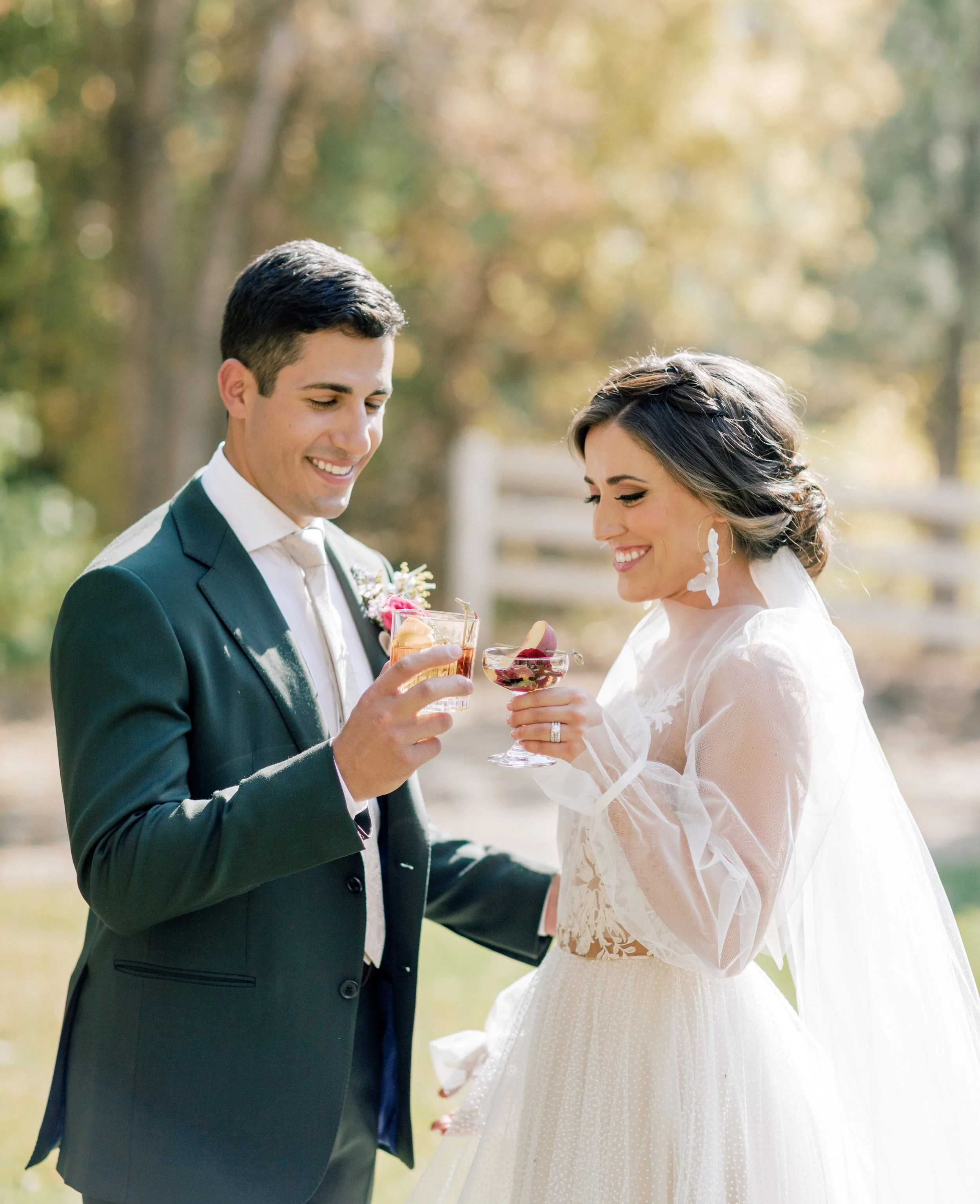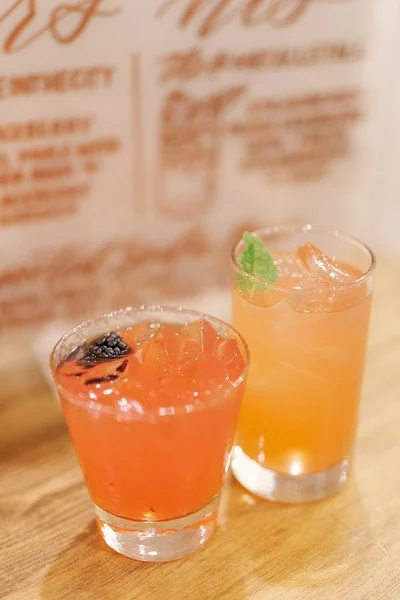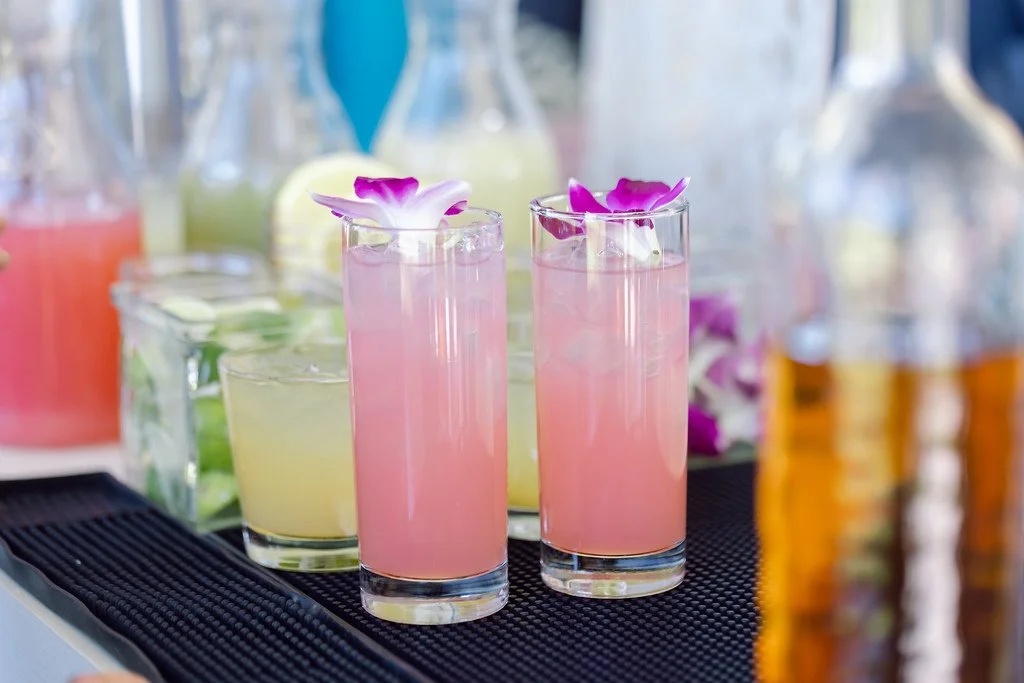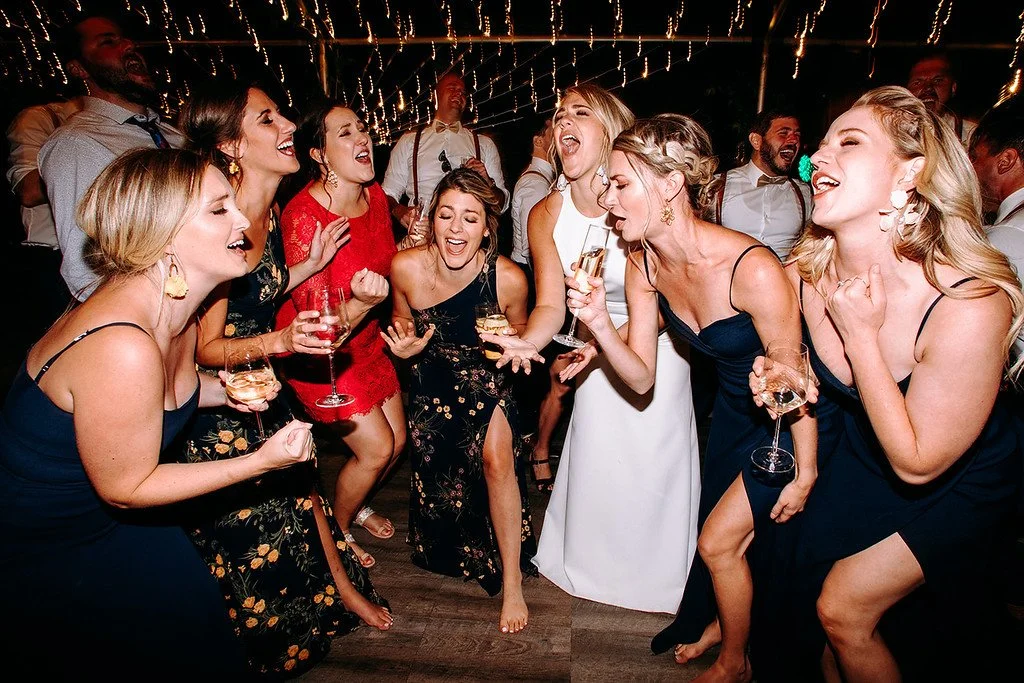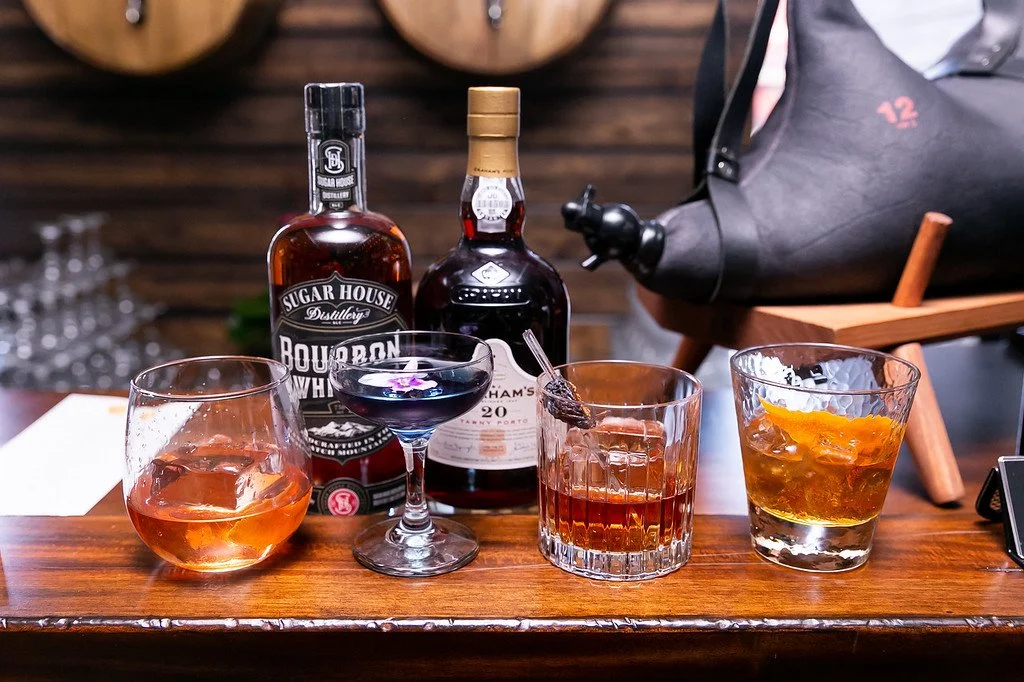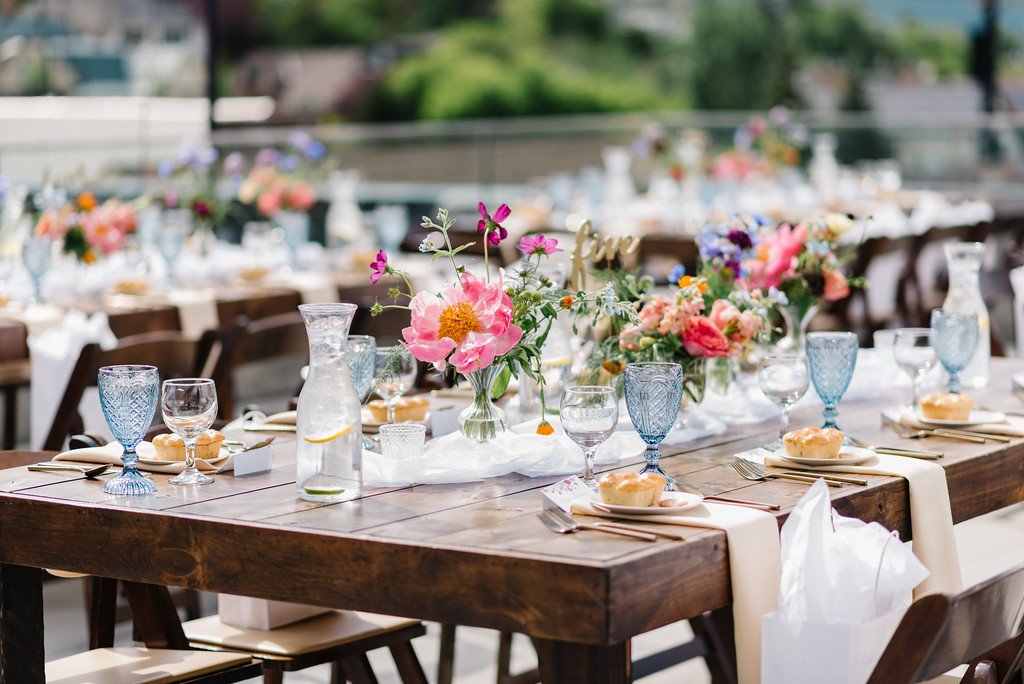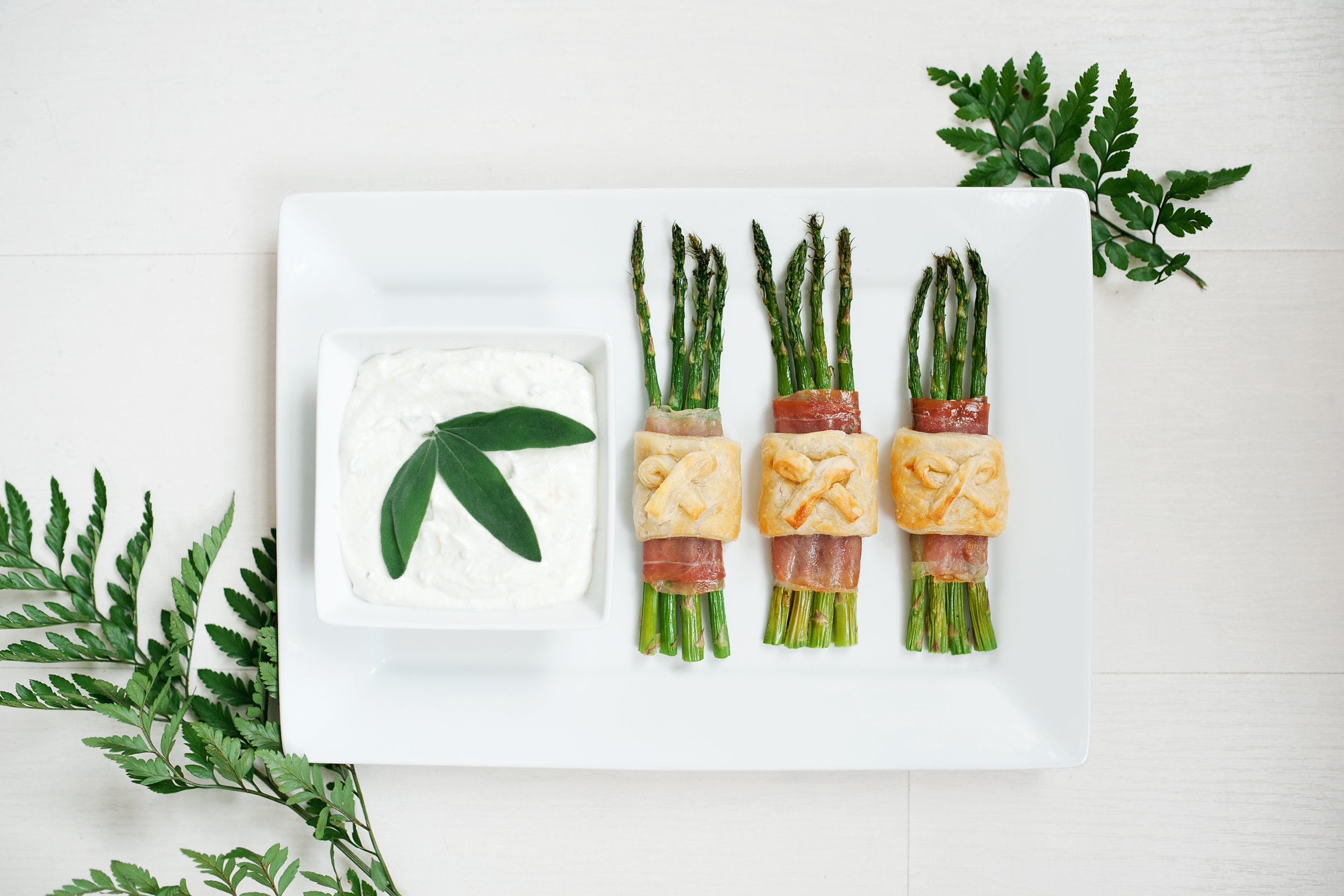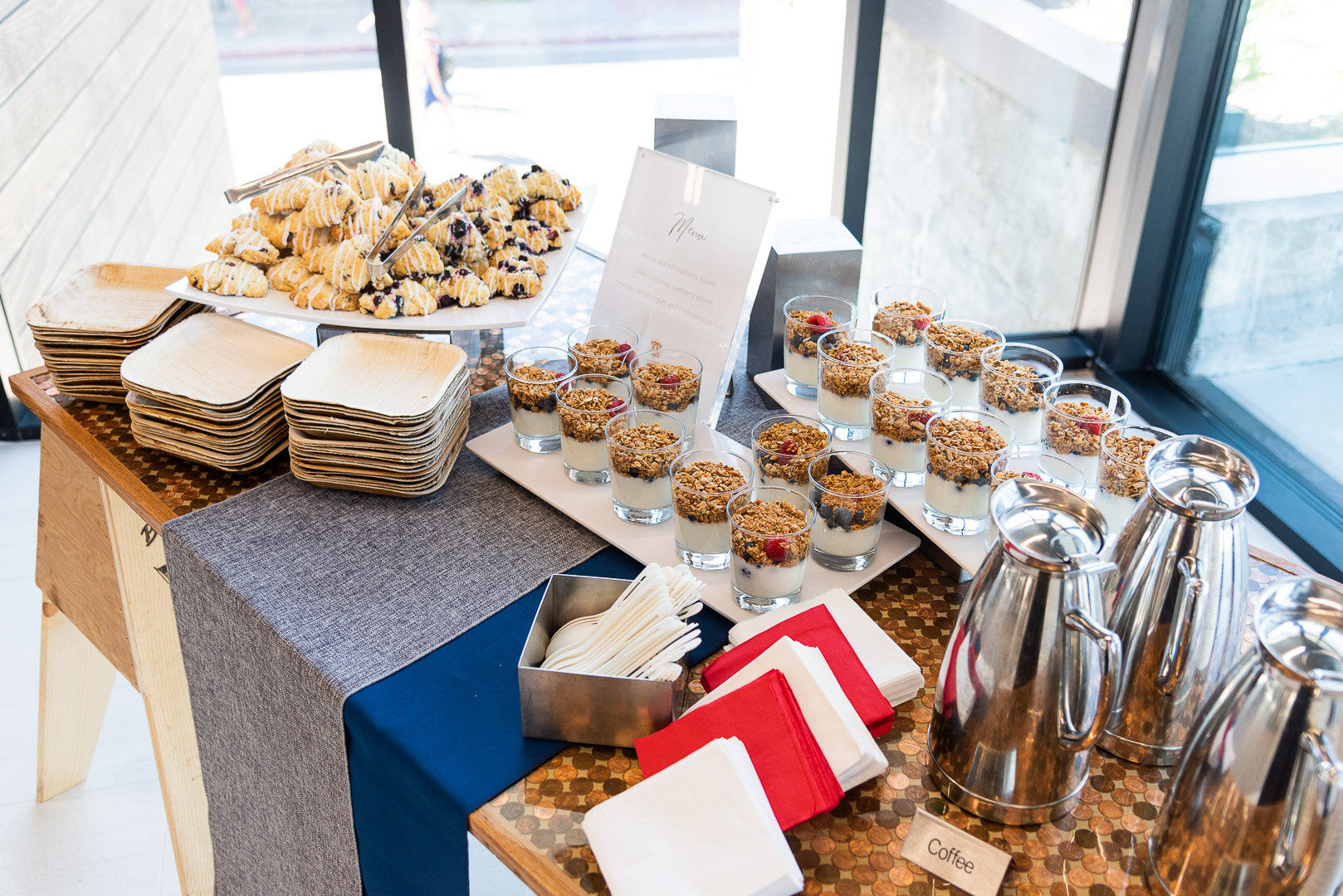Champagne? Wine and beer? Signature cocktails?
Knowing what alcohol to offer your guests—and how to serve it—can be daunting, especially if you’re not a drinker yourself. But don’t freak. Here’s what you need to know about serving (or not serving) alcohol at your wedding.
Do I need to serve alcohol at all?
The short answer is no. It’s your celebration; you can do what you want. There’s no rule that says you have to offer alcohol, or serve food, or play music, or hold a reception at all.
But if you decide to hold a party and invite guests to help you celebrate, that makes you a host, and hosting comes with obligations. First and foremost, you’re responsible to try to make your guests feel welcomed, appreciated, and comfortable, as well as keep them safe. Does that involve serving alcohol? That’s up to you.
In Utah, it’s not uncommon to see “dry” weddings where attendees are happy to sip on sodas and flavored water all evening. That’s fine if that’s what your guests expect, but you should know that in most of the world, alcohol at weddings is the norm. It’s best to communicate with your guests so they know what to expect. For example, in your invitation you might ask them to join you for “cocktails, dinner, and dancing.” Whether or not you decide to supply the booze, your guests need a heads-up.
Do I need an alcohol license?
In Utah, you do not need a liquor license or permit to serve alcohol at most weddings.
There are exceptions though. If you want a cash bar (where guests pay for their drinks) then you’ll have to hold your event at a restaurant, country club, or other venue that has a permanent liquor license. Alternatively, you can work with a vendor who will help you acquire a single use permit. Cash bars are unusual at weddings—most wedding guests don’t expect to have to pay for their food or drinks—so if you’re going to offer a cash bar, give your guests fair warning. It’s poor form to surprise them with a bill at the end of the night.
The more common approach is for the host to foot the bill, either through an open bar (where you pay in advance for all the alcohol that will be available to be served to your guests) or a hosted bar (where you pick up everyone’s tab at the end of the event). Neither of those options require a license or permit so long as your celebration is “private” (i.e. open only to invited guests).
Do I need a bartender?
Yes! Having a bartender isn’t just classy; it’s a matter of safety. If you’re going to have alcohol served, you need to make sure it’s done responsibly and legally
In Utah, as in most states, the provider or host of an event where alcohol is served can potentially be held responsible for any harm caused by an intoxicated guest. That includes driving accidents, fist fights, falling down, or even just bumping into Grandma. No one wants their wedding spoiled by an ugly incident, especially if it results in legal liability.
We strongly recommend using certified professional bartenders. Besides being covered by liquor liability insurance, your bartenders should have the knowledge and experience to keep your guests happy and safe. They’ll check IDs, mix drinks to order, prevent wait lines, and anticipate problems before they develop. Leaving the booze to the pros means you’ll be free to enjoy your celebration and not worry about whether the pinot noir is going to run out or how many whiskey sours Uncle Dan has had.
Can I afford to serve alcohol?
Alcohol can be expensive, but there are ways to cut costs:
Consider having the bar open for only a limited time during the celebration. For example, it’s a good idea to close the bar an hour before the party ends, not only to save money but also to give your guests time to sober up before they go.
Limit the drink selections. The least expensive option is to simply offer beer and wine, but a very popular, classy, and cost-effective trend is to add one or two specialty cocktails that represent the style of the bride and groom. Even if you want a full bar service, don’t offer more than four or five types of wine. (You aren’t a bar, and you don’t need an extensive wine list.)
Don’t go overboard on champagne. People don’t tend to drink a lot of champagne anyway, so it’s easy to overbuy and get stuck with a lot of wasted, expensive bubbly. Less expensive alternatives like cava, prosecco, spumante, and sparkling wines work just as well. In fact, most guests are happy to toast with whatever is in their glasses, alcoholic or not.
Offer plenty of non-alcoholic alternatives. Sodas, juices, smoothies, infused water, tea, coffee, hot chocolate, or other no-booze beverages are less expensive ways to keep your guests refreshed. Plus they show your non-drinking guests that you’re thinking of them. Your caterer can even help you formulate a virgin version of your signature cocktails.
Work with your bartender. Besides ensuring that your guests are served safely and responsibly, your bartender can also help you trim costs by steering guests towards less expensive drink options, controlling portion sizes, and cutting off someone who’s had too much.
What booze should I choose?
Unless you have guests with very specific tastes, limit your liquors to the ones with the broadest appeal. As a rule of thumb, vodka and whiskey are the most popular liquors at weddings, followed by gin and rum. If you only offered those four spirits, your bartender would be able to make about 95% of the cocktails people will request. If you’re going to offer another spirit, make it tequila, since margaritas, palomas, and Mexican mules are gaining popularity. Don’t bother with scotch unless you know a specific guest will want it.
As far as wine, bear in mind that whites and rosés become more popular as the weather gets warmer. Also, older guests tend to drink more wine while younger guests favor cocktails and specialty drinks.
How much alcohol will I need?
That depends on several factors. How many drinkers will be attending? How long will alcohol be served? What alternative beverages will be offered? Will drinks be tray-passed, or will guest have to go to the bar? Any of those factors can affect how much alcohol you’ll need. Also consider that people consume more alcohol in the evening, when dancing is involved, or when the temperature is hot. They tend to drink more when they’re offered cocktails as opposed to wine or liquor. Not surprisingly, they also drink more when they can serve themselves.
Ultimately, you’ll need to discuss this question with your caterer, but here are some basic guidelines. For an evening party, each drinking guest will have about 2 drinks in the first hour and then one drink each hour thereafter. (The longer the party goes, the less reliable that formula is.) As you’re making your calculations, remember that a bottle of wine contains about 5 servings while spirits (vodka, gin, whiskey, etc.) yield about 16 servings per average 750 mL bottle.
Where can alcohol be served?
Some Utah wedding venues won’t allow alcohol at all, and others may have specific policies or requirements. For example, you may have to let their staff do the serving, or they may require that the bar be open only while food is being served. You’ll need to ask your venue about their rules.
Where can I buy the alcohol?
You won’t need to worry about this if you ask your caterer to purchase the alcohol in your behalf, which is often how it’s done. But if you buy the alcohol yourself, be aware that, in Utah, beer is the only alcohol you can find in a grocery store. Everything else (wine, champagne, liquor, etc.) has to be purchased through the state liquor store or directly from an in-state distillery. You can’t even order it online or run to Wyoming and bring it back, since it’s illegal to bring alcohol into the state.
Our final piece of advice is this: Don’t be afraid to ask questions. As a bride, you want to make sure your guests—drinkers and non-drinkers alike—feel taken care of and have a great time, but you also want to keep everyone safe. It can be a tricky balancing act, but your planner or caterer is happy to talk you through it. Just know that it’s okay to ask.



